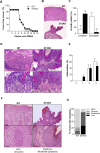ST2/IL-33 signaling promotes malignant development of experimental squamous cell carcinoma by decreasing NK cells cytotoxicity and modulating the intratumoral cell infiltrate
- PMID: 30112116
- PMCID: PMC6089399
- DOI: 10.18632/oncotarget.25768
ST2/IL-33 signaling promotes malignant development of experimental squamous cell carcinoma by decreasing NK cells cytotoxicity and modulating the intratumoral cell infiltrate
Abstract
Squamous cell carcinoma (SCC) is the second most common form of skin cancer and the mechanism(s) involved in the progression of this tumor are unknown. Increases in the expression of IL-33/ST2 axis components have been demonstrated to contribute to neoplastic transformation in several tumor models and interleukin-33 is correlated with poor prognosis of patients with squamous cell carcinoma of the tongue. Based on these observations, we sought to determine the role of the IL-33/ST2 pathway during the development of SCC. Our findings show that ST2-deficiency led to a marked decrease in the severity of skin lesions, suggesting that ST2 signaling contributed to tumor development. An analysis of tumor lesions in wild-type and ST2KO mice revealed that a lack of ST2 was associated with specific and significant reductions in the numbers of CD4+ T cells, CD8+ T cells, dendritic cells, and macrophages. In addition, NK cells that were isolated from ST2KO mice exhibited higher cytotoxic activity than cells isolated from wild-type mice. Notably, ST2 deficiency resulted in lower IFN-γ, TNF-α, IL-10, and IL-17 production in tumor samples. Our findings indicate that the IL-33/ST2 pathway contributes to the development of SCC by affecting leukocyte migration to tumor microenvironment and impairing NK cytotoxic activity.
Keywords: IL-33; ST2; chemical carcinogenesis; immune modulation; squamous cell carcinoma.
Conflict of interest statement
CONFLICTS OF INTEREST The authors declare that they have no conflicts of interest.
Figures




References
-
- Domingo DS, Baron ED. Melanoma and nonmelanoma skin cancers and the immune system. Adv Exp Med Biol. 2008;624:187–202. - PubMed
-
- Brantsch KD, Meisner C, Schönfisch B, Trilling B, Wehner-Caroli J, Röcken M, Breuninger H. Analysis of risk factors determining prognosis of cutaneous squamous-cell carcinoma: a prospective study. Lancet Oncol. 2008;9:713–720. - PubMed
-
- Curry JM, Sprandio J, Cognetti D, Luginbuhl A, Bar-Ad V, Pribitkin E, Tuluc M. Tumor microenvironment in head and neck squamous cell carcinoma. Semin Oncol. 2014;41:217–234. - PubMed
-
- Wakita D, Chamoto K, Ohkuri T, Narita Y, Ashino S, Sumida K, Nishikawa H, Shiku H, Togashi Y, Kitamura H, Nishimura T. IFN-γ-dependent type 1 immunity is crucial for immunosurveillance against squamous cell carcinoma in a novel mouse carcinogenesis model. Carcinogenesis. 2009;30:1408–1415. - PubMed
LinkOut - more resources
Full Text Sources
Other Literature Sources
Research Materials

